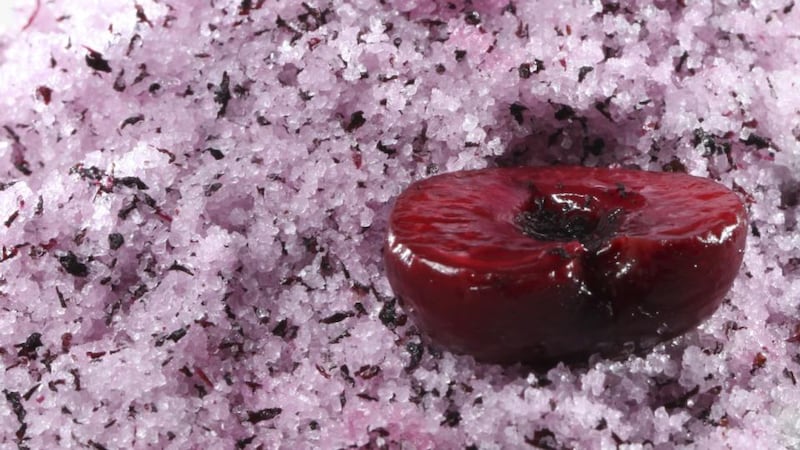Ferran Adrià holds a watery tomato up like a ruby. Then he tosses it in the air, pulls out a six shooter and blasts it to pulp. Pow. Okay that last bit happened metaphorically but you get the picture.
The world’s most famous chef is talking food. He is ringmaster and clown, all bounce and bottle in blue Nikes, navy chinos and a long sleeve charcoal sweat top that looks like someone hacked the waistband off with a blunt scissors. Each time he waves his long arms in the air (something he does a lot) the top lifts to reveal a muffin-top midriff. He doesn’t seem to give a damn. The Spanish chef who changed restaurant food for a generation has bigger things on his crowded mind.
“Is this tomato natural?” he asks, holding up the watery looking specimen. “No. You won’t find that in nature.” The only natural tomato is to be found in the Andes. “It’s a wild tomato and you wouldn’t eat it. So the worst tomato in the world” as he calls his specimen “is still better than a natural tomato. It’s a lie that natural is better.”

Turning ideas on their heads is Adrià’s schtick. We’re in a grey conference room in Barcelona, a group of journalists, chefs and bar owners brought here by the city’s oldest brewery Estrella Damm. “Currently I almost do nothing related to gastronomy,” the 52-year-old Catalan chef tells us. “I haven’t been to any gastronomical conference for four years now.”
That hasn’t dented his ability to talk. He draws circles, lots of circles. Unreadable words dribble out of the green marker. Later someone will hop onto the stage and tear off a sheet, to get a piece of Adrià memorabilia. “We should put the tomato on eBay,” one wag mutters as we pass the podium.
The tomato is at the heart of Ferran Adrià’s new project: deconstructing the idea of food, its language, history, anthropology and culture. ElBulli the restaurant has morphed into elBulli the lab, home to what he calls the Sapiens project. “I want to know the tomato to create and I want to know the tomato to educate,” he says. “Our challenge is to make people think in a different way.” It’s big picture stuff.
At one point a Scottish chef asks him about one of his famous dishes. But Adrià won’t revisit his past creativity. “Are you married?” he asks the chef. “Sort of.” “Do you have children?” “No.” “Are you brave?” “Yes.” Then Adrià slips into motivational speaker mode. “Look at yourself in the mirror and ask: who do I want to be today?” he says, eyes glinting. “Consequences depend on what you do . . . There is no super bullet. Everyone has to find his own way.”
We are, he says at one point with a grin reminiscent of Gene Wilder’s Willy Wonka, “living in an imaginary reality”.
So far so cerebral but there's another project and it's less food geek and more party animal. He's returning full circle this summer to a teenage season in Ibiza working as a chef at the hotel Club Cala Llenya. You can see a picture of him from 1981 in Colman Andrews's book Reinventing Food: Ferran Adrià, The Man who Changed the way We Eat, (a must read for Adrià anoraks). Dressed in grimy chef's whites he's sporting what Andrews calls "a Catalan Afro."
The brown curls have receded and greyed but in July Adrià’s Heart project, a collaboration with Cirque du Soleil, will be unleashed. “It’s the creative collision of art, food and music,” he says, “to completely change the concept of a restaurant, of a cabaret.” Over 3,000sq m, Heart will feature a casino, a “sound cleansing tunnel”, body painting, street food in the “hippy spirit” and gastronomy.
“There’ll be no Michelin stars, none of that, just fiesta, having fun, very informal,” Adrià says. Downstairs will be a workshop “a kind of restaurant, one of the hardest projects I’ve ever worked on. The tables are not very big. They are quite low. The chairs are all different so it doesn’t look like a restaurant.”
Here you might "travel the world in 80 oysters", or eat caviar from a caviar spider, a high bowl on three spidery legs because caviar "at €900 a kilo is not expensive these days. Gambas [shrimp] are more expensive". Waiters will put a small chair on your table as a prop to serve the nigiri, the jamón will be served on a golden ham. Other serving implements include a tapas box, a "surprise frog" and an oyster tongue.
Adrià is taking fun very seriously. There is no sense that he misses the old day job. “People came to elBulli wanting the most amazing day of their lives,” he says. That meant working under a lot of pressure. “ElBulli is the 2,500 cooks that worked there. Nowadays many are the most influential in the world.”
Restaurant food is not art, he says. “There’s no art because it’s handcraft. They [chefs] are handcrafters. They’re not an industry. They work with their hands.”
We head outside to a warehouse building in Carrer Mexic a short walk away. At the top of a steep ramp (there is no official door as it’s only open to employees) the elBulli lab is a surprisingly food-free zone. There are no kitchens, Pacojets or spherifiers. Instead door size slabs of styrofoam are arranged on stands with words and pictures pinned to them. Some form room dividers, as if ideas were furniture.
About a dozen people are working on laptops. It’s like a library or a start-up without the foosball table. Head of the lab, chef Eugeni de Diego shows us round.
To the outsider it all looks a bit bonkers. One styrofoam panel has tiny strips of paper with the Latin and Catalan names of plants, each strip cut from a printout and pinned in lines, a painstakingly physical act of display in the digital age. Wandering around feels like being inside someone’s head.
Hanging from the ceiling on string are Adrià’s many magazine covers in plastic bags. The Sapiens project is going to take 10 years and €20 million, de Diego explains. Its Bullipedia website, apps and collection will be a teaching resource for cooking schools. And the funding? It comes from firms like Telefónica, Dom Pérignon and other “business angels”.
The next morning we see the clattering and robotically-beating heart of one of those angels in the Estrella Damm factory near Barcelona airport. Spain’s oldest brewery was set up in 1876 when August K Damm came to Spain from Alsace with his wife Melanie. He added rice beer to a typical Alsace recipe for a warmer climate. It’s factories like this that fund think tanks like the elBulli lab to send its intricate handcrafted information into a world accustomed to a faster brain food diet.
Estrella Damm lager has now arrived in Ireland and Britain and Adrià’s Inedit beer, a blend he designed for Damm in 2009, is also available here. Ironically, for a man who has published 38 books, Inedit is Catalan for “unpublished”.
















